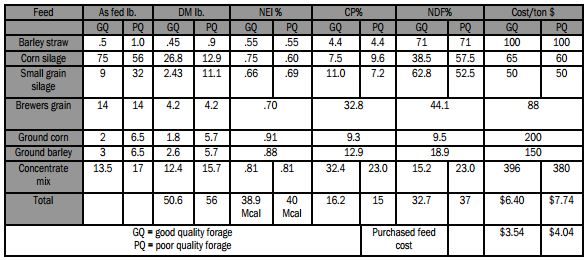



The Impact of Forage Quality on Ration Cost and Feed Inventory
Forage decisions over the coming weeks have long term impacts on expenses and costs which is why last winter was so hard as forage had poor fermentation and little starch, reports R E James, Dairy Nutrition expert at Virginia State University Extension.What a producer does in the next four months has profound effects on the economy of the feeding program and the forage inventory for the coming year, writes Mr James.
One of the biggest determinants of quality of forages for many east coast farms is weather throughout the growing season. Some years the rains never seem to come and when they do it's at the wrong time.
In other years, it seems like things everything falls into place for high yields and quality. For those farms with access to water for irrigation, the risk of a bad crop year can be avoided. In addition to availability of moisture, timing the harvest at optimum plant maturity is equally important.
Consider the following example.
Last year’s feeding program was a dream for the nutritionist, the farmer, and the cows & corn silage and barley silage were excellent quality. The next year was the pits! The weather was dry until just before the custom chopper arrived and then it rained.
The corn silage was too wet and very low in energy. It had a poor fermentation and contained little starch. The only saving grace was that a good spring permitted the harvest of limited quantities of some excellent barley silage. Rations for each are shown in the table below.
Note several things about these rations which presents opportunities and challenges.
*
"The main message is that changes inforage quality have a dramatic impact on expenses, income and forage inventories."
The ration with good quality forage uses less corn, barley and concentrate and more cornsilage. Corn and barley were grown on the farm and purchased feed cost was $.50 less per cow per day when good quality corn silage was available. This resulted in a reduction in purchased feed of over $18,000 annually for every 100 cows.
It also allowed a significant carryover of corn and barley stocks for the next year. One might also question whether the cows fed poor quality forage could consume 56 lb. of dry matter, so milk production might also suffer.
In contrast, the cows fed the high quality ration might eat more dry matter and produce more milk. The challenge with high quality forage is that given this ration, the producer would feed 19 lb. more corn silage daily or 350 more tons of silage annually forevery 100 milking cows.
The producer in this example was accustomed to harvesting average quality feed and had budgeted accordingly at beginning of the fall. The nutritionist, maximized the use of the high quality silage and formulated rations which were economical, but resulted in depletion of the corn silage supply two months prior to the beginning of the harvest season.
The main message here is that changes inforage quality have a dramatic impact on expenses, income and forage inventories. Effective managers should do everything in their power to facilitate the harvest and storage of high quality forages to improve farm profit.
Additionally, producers should plan to harvest sufficient forage tonnage to accommodate, years when quality is high and monitor forage inventory at least monthly to assure that there is sufficient forage to account for differences in quality.
July 2013




